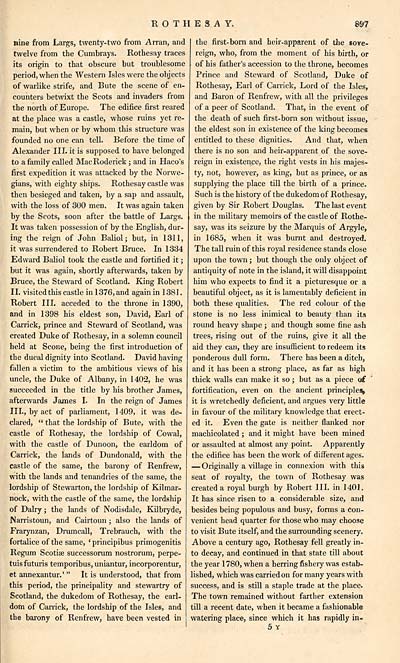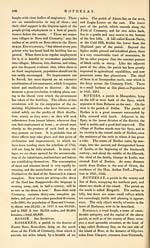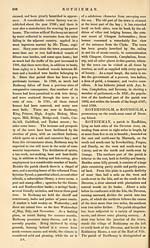Gazetteer of Scotland > Volume 2
(417) Page 897
Download files
Complete book:
Individual page:
Thumbnail gallery: Grid view | List view

ROTHESAY.
897
nine from Largs, twenty-two from Arran, and
twelve from the Cumbrays. Rothesay traces
its origin to that obscure but troublesome
period, when the Western Isles were the objects
of warlike strife, and Bute the scene of en-
counters betwixt the Scots and invaders from
the north of Europe. The edifice first reared
at the place was a castle, whose ruins yet re-
main, but when or by whom this structure was
founded no one can tell. Before the time of
Alexander III. it is supposed to have belonged
to a family called MacRoderick ; and in Haco's
first expedition it was attacked by the Norwe-
gians, with eighty ships. Rothesay castle was
then besieged and taken, by a sap and assault,
with the loss of 300 men. It was again taken
by the Scots, soon after the battle of Largs.
It was taken possession of by the English, dur-
ing the reign of John Baliol; but, in 1311,
it was surrendered to Robert Bruce. In 1334
Edward Baliol took the castle and fortified it ;
but it was again, shortly afterwards, taken by
Bruce, the Steward of Scotland. King Robert
II. visited this castle in 1376, and again in 1381.
Robert III. acceded to the throne in 1390,
and in 1398 his eldest son, David, Earl of
Carrick, prince and Steward of Scotland, was
created Duke of Rothesay, in a solemn council
held at Scone, being the first introduction of
the ducal dignity into Scotland. David having
fallen a victim to the ambitious views of his
uncle, the Duke of Albany, in 1402, he was
succeeded in the title by his brother James,
afterwards James I. In the reign of James
III., by act of parliament, 1409, it was de-
clared, " that the lordship of Bute, with the
castle of Rothesay, the lordship of Cowal,
with the castle of Dunoon, the earldom of
Carrick, the lands of Dundonald, with the
castle of the same, the barony of Renfrew,
with the lands and tenandries of the same, the
lordship of Stewarton, the lordship of Kilmar-
nock, with the castle of the same, the lordship
of Dairy ; the lands of Nodisdale, Kilbryde,
Narristoun, and Cairtoun ; also the lands of
Frarynzan, Drumcall, Trebrauch, with the
fortalice of the same, * principibus primogenitis
Regum Scotia? successorum nostrorum, perpe-
tuis futuris temporibus, uniantur, incorporentur,
et annexantur.' " It is understood, that from
this period, the principality and stewartry of
Scotland, the dukedom of Rothesay, the earl-
dom of Carrick, the lordship of the Isles, and
the barony of Renfrew, have been vested in
the first-born and heir-apparent of the sove-
reign, who, from the moment of his birth, or
of his father's accession to the throne, becomes
Prince and Steward of Scotland, Duke of
Rothesay, Earl of Carrick, Lord of the Isles,
and Baron of Renfrew, with all the privileges
of a peer of Scotland. That, in the event of
the death of such first-born son without issue,
the eldest son in existence of the king becomes
entitled to these dignities. And that, when
there is no son and heir-apparent of the sove-
reign in existence, the right vests in his majes-
ty, not, however, as king, but as prince, or as
supplying the place till the birth of a prince.
Such is the history of the dukedom of Rothesay,
given by Sir Robert Douglas. The last event
in the military memoirs of the castle of Rothe-
say, was its seizure by the Marquis of Argyle,
in 1685, when it was burnt and destroyed.
The tall ruin of this royal residence stands close
upon the town; but though the only object of
antiquity of note in the island, it will disappoint
him who expects to find it a picturesque or a
beautiful object, as it is lamentably deficient in
both these qualities. The red colour of the
stone is no less inimical to beauty than its
round heavy shape ; and though some fine ash
trees, rising out of the ruins, give it all the
aid they can, they are insufficient to redeem its
ponderous dull form. There has been a ditch,
and it has been a strong place, as far as high
thick walls can make it so ; but as a piece of
fortification, even on the ancient principles,
it is wretchedly deficient, and argues very little
in favour of the military knowledge that erect-
ed it. Even the gate is neither flanked nor
machicolated ; and it might have been mined
or assaulted at almost any point. Apparently
the edifice has been the work of different ages.
— Originally a village in connexion with this
seat of royalty, the town of Rothesay was
created a royal burgh by Robert III. in 1401.
It has since risen to a considerable size, and
besides being populous and busy, forms a con-
venient head quarter for those who may choose
to visit Bute itself, and the surrounding scenery.
Above a century ago, Rothesay fell greatly in-
to decay, and continued in that state till about
the year 1 780, when a herring fishery was estab-
lished, which was carried on for many years with
success, and is still a staple trade at the place.
The town remained without farther extension
till a recent date, when it became a fashionable
watering place, since which it has rapidly in-
5 Y
897
nine from Largs, twenty-two from Arran, and
twelve from the Cumbrays. Rothesay traces
its origin to that obscure but troublesome
period, when the Western Isles were the objects
of warlike strife, and Bute the scene of en-
counters betwixt the Scots and invaders from
the north of Europe. The edifice first reared
at the place was a castle, whose ruins yet re-
main, but when or by whom this structure was
founded no one can tell. Before the time of
Alexander III. it is supposed to have belonged
to a family called MacRoderick ; and in Haco's
first expedition it was attacked by the Norwe-
gians, with eighty ships. Rothesay castle was
then besieged and taken, by a sap and assault,
with the loss of 300 men. It was again taken
by the Scots, soon after the battle of Largs.
It was taken possession of by the English, dur-
ing the reign of John Baliol; but, in 1311,
it was surrendered to Robert Bruce. In 1334
Edward Baliol took the castle and fortified it ;
but it was again, shortly afterwards, taken by
Bruce, the Steward of Scotland. King Robert
II. visited this castle in 1376, and again in 1381.
Robert III. acceded to the throne in 1390,
and in 1398 his eldest son, David, Earl of
Carrick, prince and Steward of Scotland, was
created Duke of Rothesay, in a solemn council
held at Scone, being the first introduction of
the ducal dignity into Scotland. David having
fallen a victim to the ambitious views of his
uncle, the Duke of Albany, in 1402, he was
succeeded in the title by his brother James,
afterwards James I. In the reign of James
III., by act of parliament, 1409, it was de-
clared, " that the lordship of Bute, with the
castle of Rothesay, the lordship of Cowal,
with the castle of Dunoon, the earldom of
Carrick, the lands of Dundonald, with the
castle of the same, the barony of Renfrew,
with the lands and tenandries of the same, the
lordship of Stewarton, the lordship of Kilmar-
nock, with the castle of the same, the lordship
of Dairy ; the lands of Nodisdale, Kilbryde,
Narristoun, and Cairtoun ; also the lands of
Frarynzan, Drumcall, Trebrauch, with the
fortalice of the same, * principibus primogenitis
Regum Scotia? successorum nostrorum, perpe-
tuis futuris temporibus, uniantur, incorporentur,
et annexantur.' " It is understood, that from
this period, the principality and stewartry of
Scotland, the dukedom of Rothesay, the earl-
dom of Carrick, the lordship of the Isles, and
the barony of Renfrew, have been vested in
the first-born and heir-apparent of the sove-
reign, who, from the moment of his birth, or
of his father's accession to the throne, becomes
Prince and Steward of Scotland, Duke of
Rothesay, Earl of Carrick, Lord of the Isles,
and Baron of Renfrew, with all the privileges
of a peer of Scotland. That, in the event of
the death of such first-born son without issue,
the eldest son in existence of the king becomes
entitled to these dignities. And that, when
there is no son and heir-apparent of the sove-
reign in existence, the right vests in his majes-
ty, not, however, as king, but as prince, or as
supplying the place till the birth of a prince.
Such is the history of the dukedom of Rothesay,
given by Sir Robert Douglas. The last event
in the military memoirs of the castle of Rothe-
say, was its seizure by the Marquis of Argyle,
in 1685, when it was burnt and destroyed.
The tall ruin of this royal residence stands close
upon the town; but though the only object of
antiquity of note in the island, it will disappoint
him who expects to find it a picturesque or a
beautiful object, as it is lamentably deficient in
both these qualities. The red colour of the
stone is no less inimical to beauty than its
round heavy shape ; and though some fine ash
trees, rising out of the ruins, give it all the
aid they can, they are insufficient to redeem its
ponderous dull form. There has been a ditch,
and it has been a strong place, as far as high
thick walls can make it so ; but as a piece of
fortification, even on the ancient principles,
it is wretchedly deficient, and argues very little
in favour of the military knowledge that erect-
ed it. Even the gate is neither flanked nor
machicolated ; and it might have been mined
or assaulted at almost any point. Apparently
the edifice has been the work of different ages.
— Originally a village in connexion with this
seat of royalty, the town of Rothesay was
created a royal burgh by Robert III. in 1401.
It has since risen to a considerable size, and
besides being populous and busy, forms a con-
venient head quarter for those who may choose
to visit Bute itself, and the surrounding scenery.
Above a century ago, Rothesay fell greatly in-
to decay, and continued in that state till about
the year 1 780, when a herring fishery was estab-
lished, which was carried on for many years with
success, and is still a staple trade at the place.
The town remained without farther extension
till a recent date, when it became a fashionable
watering place, since which it has rapidly in-
5 Y
Set display mode to: Large image | Transcription
Images and transcriptions on this page, including medium image downloads, may be used under the Creative Commons Attribution 4.0 International Licence unless otherwise stated. ![]()
| Gazetteers of Scotland, 1803-1901 > Gazetteer of Scotland > Volume 2 > (417) Page 897 |
|---|
| Permanent URL | https://digital.nls.uk/97435826 |
|---|
| Description | Volume II: Glenbanchor to Zetland. |
|---|---|
| Attribution and copyright: |
|
| Description | By Robert Chambers and William Chambers. Glasgow: Blackie & Son, 1838. 2 volumes. |
|---|---|
| Shelfmark | NF.1461.g.7 |
| Additional NLS resources: | |

